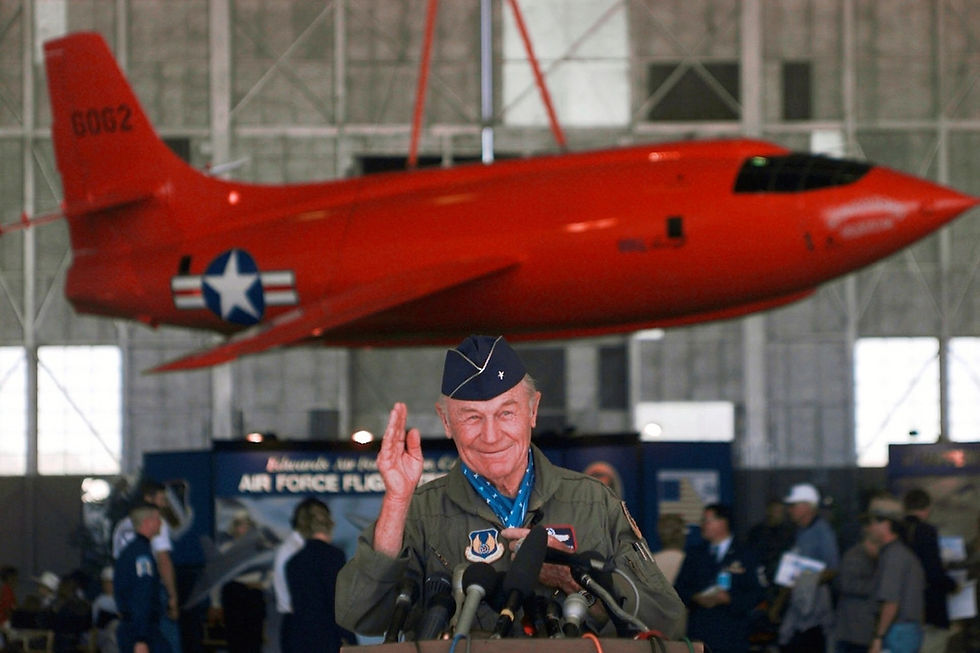This Week in Military History - Chuck Yeager Breaks the Sound Barrier.
- Jacksonville Museum
- Oct 9, 2024
- 3 min read

On October 14, 1947, the Bell X-1 became the first airplane to fly faster than the speed of sound. Piloted by U.S. Air Force Captain Charles E. "Chuck" Yeager, it reached 700 miles per hour in an X-1 he named "Glamorous Glennis" after his wife.
Yeager enlisted as a private in the U.S. Army Air Forces on September 12, 1941, and became an aircraft mechanic at George Air Force Base. Because of his age and educational background, he was not eligible for flight training when he enlisted. However, the U.S. entry into World War II prompted the USAAF to alter its recruiting standards. Yeager graduated from flight training at Luke Field, Arizona, on March 10, 1943.
Initially, he trained as a fighter pilot, flying the Bell P-39, and was sent overseas on November 23, 1943. Stationed in the United Kingdom at RAF Leiston, Yeager flew P-51 Mustangs with the 363rd Fighter Squadron.
He named his aircraft Glamorous Glennis after his girlfriend, Glennis Faye Dickhouse, who became his wife in February 1945. Yeager was shot down over France in his first aircraft on March 5, 1944, and escaped to Spain with the help of the French Resistance. Despite a regulation prohibiting "evaders" from flying over enemy territory again, Yeager was reinstated to flying combat after speaking directly to General Eisenhower. Yeager demonstrated outstanding flying skills and combat leadership, becoming the first pilot in his group to make "ace in a day" on October 12, 1944. He finished the war with 11.5 official victories, including one of the first air-to-air victories over a jet fighter. Yeager was commissioned a second lieutenant and promoted to captain before the end of his tour. Upon returning to the United States, he became a functional test pilot of repaired aircraft.

After the war, Yeager remained in the U.S. Army Air Forces, becoming a test pilot at Muroc Army Air Field (now Edwards Air Force Base) after graduating from Air Materiel Command Flight Performance School (Class 46C). After Bell Aircraft test pilot Chalmers "Slick" Goodlin demanded US$150,000 to break the sound barrier, the USAAF selected the 24-year-old Yeager to fly the rocket-powered Bell XS-1 in a NACA program to research high-speed flight. Under the National Security Act of 1947, the USAAF became the United States Air Force (USAF) on September 18. Two nights before the scheduled flight date, Yeager broke two ribs when he fell from a horse. He was worried that the injury would remove him from the mission and reported that he went to a civilian doctor in nearby Rosamond, who taped his ribs. On the day of the flight, Yeager was in pain and could not seal the X-1's hatch alone. Ridley rigged up a device, using the end of a broom handle as an extra lever, to allow Yeager to seal the hatch.
Yeager broke the sound barrier on October 14, 1947, and continued to break speed and altitude records. He flew a chase aircraft for Jackie Cochran as she became the first woman to fly faster than sound. Yeager and Ridley set a new speed record at Mach 2.44 on December 12, 1953, but Yeager lost control of the X-1A shortly after, experiencing inertia coupling. Despite the dangerous situation, Yeager regained control and landed the aircraft, earning the Distinguished Service Medal in 1954.

When an airplane goes in for heavy depot maintenance they are taken apart almost down the shell and then reassembled. Before the plane is sent back to general use, it goes through heavy testing, including shutting down the plane while it is in flight, engine checks, and gauge checks, to name a few. The pilots who test these planes are called functional test pilots, and Yeager was one of them.
While not on display, the museum has examples of functional test pilot uniforms, like the one that Yeager would have worn after the war and like ones still being worn today.

Opmerkingen